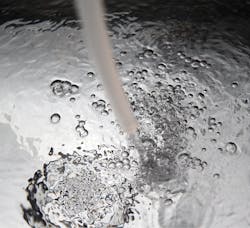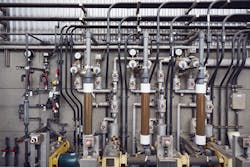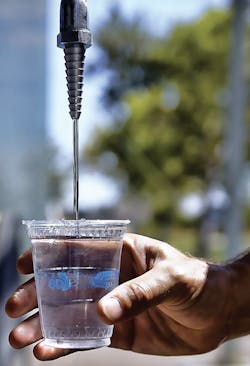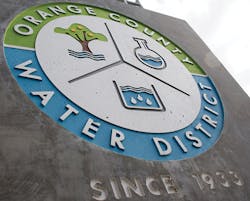Ultrapure water flows out of the tasting sinks at OCWD’s GWRS facility. Photo courtesy OCWD.
Utilities’ water reuse projects aim to expand dwindling supplies
By Alanna Maya
Severe drought, dwindling local water supplies and the high costs associated with imported water have many utilities looking for new ways to increase their local drinking water supplies to fill future needs. In Southern California, several public and private utilities have chosen water reuse as the answer to these problems.
“In California, these treatment processes are called AWT’s, or advanced water treatment plants,” said Mehul V. Patel, P.E., Orange County Water District’s (OCWD) director of water production. He oversees the operations, maintenance and staff responsible for the day-to-day activities of the Groundwater Replenishment System (GWRS) facility and has been with the District for 18 years. “Our [state] regulations now require that any indirect potable reuse project — which is what these kinds [of processes] are considered — follows this same treatment train: microfiltration, then reverse osmosis, and finally UV light and chemical treatment.”
Since the mid-1970s, OCWD has been a leader in the reuse of municipal wastewater. In 1975, the district opened Water Factory 21 (WF 21), which took treated wastewater from the Orange County Sanitation District (OCSD), blended it with deep well water and injected it into the basin at a local ocean outfall. The facility was the first in the world to use reverse osmosis to purify wastewater to drinking water standards in 1977, treating a maximum of 15 million gallons a day (MGD) while offsetting the total amount of wastewater effluent being discharged into the Pacific Ocean. By 1990, WF 21’s 15 MGD capacity was not enough to meet the needs of the growing population and the district began looking at expansion. The ocean outfall in use by OCSD was also near capacity, and so, the two agencies collaborated on a solution and expanded their reuse efforts together.
“It was a perfect storm because the Sanitation District needed to get rid of its treated wastewater, we needed to find another source of replenishment water to fill our aquifer and we needed to upgrade the old seawater intrusion barrier plant. So that all came together and we partnered up to build the GWRS,” Patel said.
The GWRS facility, which repurposes 100 MGD of municipal wastewater through microfiltration, reverse osmosis, and ultraviolet light with hydrogen peroxide before returning it to the drinking water supply, has been the poster-child for AWT in the state since coming on-line in 2008.
“The partnership [between OCWD and OCSD] is what made the program really unique,” Patel said. “By the sanitation district needing us to help decrease its ocean discharge levels, [and our needs for] more flow, they literally were a financial partner [as well].”
In fact, about $200 million of the total $481 million in construction costs for the initial 70 MGD GWRS facility came from OCSD. Currently, the sanitation district “gifts” its treated wastewater to OCSD and takes back all of the waste stream from the GWRS facility at no cost. The relationship provides a significant cost savings for the water district, Patel said.
In 2015, the GWRS completed a $143 million, 30 MGD expansion project. In addition to increasing local potable water supply, the program has significantly decreased the amount of wastewater discharged into the Pacific Ocean — all while providing enough water for about 850,000 people. The Groundwater Replenishment System Final Expansion Project (GWRSFEP) will increase the program’s treatment capacity to 130 MGD, and is expected to be completed by December 2023.
And the partnership between OCWD and OCSD is ongoing. While most wastewater treatment plants (WWTPs) have a collection system that routinely scans for oils, grease and environmental contaminants, OCSD’s enhanced source control tests for drinking water contaminants before sending water to GWRS for treatment. OCWD then screens for over 400 contaminants during its process. If plant managers find something they believe to be coming from the WWTP, they communicate and the two agencies work together to find the source of the contaminant and a treatment solution.
The OCWD’s Groundwater Replenishment System currently repurposes 100 MGD of municipal wastewater. At full build-out, the program will supply 130 MGD of advanced treated water to Orange County residents. Photo courtesy OCWD.
“Our [treatment] model and [interagency] cooperation is something that other [utilities] are trying to follow,” Patel said, “realizing that they need to work together because the wastewater treatment plant has an influence on what happens at the reclamation plant.”
As the area’s major success story, OCWD has worked with other agencies to set up their own AWT programs, hosting engineers and utility representatives from agencies in Southern California and as far as Australia and Singapore. While visitors are of course curious about the treatment process, Patel said the agencies broad public acceptance and minimal community pushback seems to be the biggest draw.
“What we share with a lot of other agencies, more than just our treatment process, is that before we even put pen to paper on a preliminary design, we had already started our community outreach,” Patel said. “The message was very honest in terms of telling people, literally, that this is treated wastewater that we are going to turn into beyond drinking water quality and it is going to mix with the other drinking water supplies, but none of it will go directly to your house. It will be part of the water supply indirectly, and it is what we have to do in order to keep up with demand in this area.”
Patel underscored the importance of not only being up front and honest but also having the staff do all of the outreach and the presentations rather than consultants or PR firms. “We tell everyone that they need to use the staff that actually run the plant, teach them how to speak publicly, be honest and not to use a lot of jargon.”
Water at the GWRS goes through several treatment processes before being sent to be mixed in with the local drinking water supply. Photo courtesy OCWD.
OCWD has hosted hundreds of facility tours and “tastings” at the GWRS, and is a staple at community fairs and outreach programs. “A big part of our ongoing outreach is conducting tours of our facility,” Patel said. “We don’t turn anyone down, even if a single person calls, we will give them a tour where they get a chance to taste the water here.” Patel noted the recent passing of state legislation that allows the facility to bottle a small portion of the water produced there. “So we have been able to bring the water to events like festivals and community fairs so that people who cannot come to the plant can see the water, taste it and see that it is safe,” he said. “We are a big believer that the outreach can never stop, and that it has to be early and often.”
Building More Local Supplies
About an hour or so north of OCWD, the Metropolitan Water District of Southern California (Metropolitan) delivers an average of over 2 billion gallons of water a day to 19 million customers across Southern California. About 55 percent of water provided to Metropolitan customers comes from outside sources like the Colorado River. Recently, Metropolitan launched a water recycling program in conjunction with the Sanitation Districts of Los Angeles County and broke ground on a 500,000-gallon-per-day demonstration facility. The Advanced Purification Center is expected to begin operations by the end of 2018.
Tastings conducted at the PURE Water Program demonstration facility allow visitors from the community to sample the water that will become part of their drinking water supply. Photo courtesy City of San Diego.
Jeffrey Kightlinger, who is the general manager and chief executive officer for Metropolitan said the Regional Recycled Water Program is one of the agency’s largest undertakings in its history.
“Early on, we came to the realization that our imported supply was not growing; and if anything [these water sources] are getting more constricted over time, while our region is continuing to grow in population,” he said. “So, we had to come up with a plan to serve our region on a flat baseline of imported water.” According to Kightlinger, Metropolitan had to do two things: ensure the continued reliability of the baseline imported supply by continuing to invest in it and maintain it; and develop new local supplies to accommodate growth in the area through conservation, demand management reduction and local resources.
In the early 1990s, Metropolitan began supporting local reuse projects through subsidies to offset the cost of imported water. Subsidies are designed to make local projects cost-competitive with Metropolitan’s imported water, which is relatively inexpensive because of the large volume of water being moved by the agency. The money comes from a public goods charge Metropolitan calls its water stewardship rate, a fee attached to each drop of imported water the agency sells. Today, about 400,000 acre-feet of water a year is recycled in Southern California annually through its local resources project plan program, including OCWD’s GWRS facility, which partnered with Metropolitan on subsidizing the early stages of development for its water recycling program.
“We have now subsidized over three dozen projects throughout Southern California, and the program has worked quite well,” Kightlinger said, “but we are seeing that we have already picked off some of the low hanging fruit, and the easier projects have been [addressed].”
OCWD has been a leader in the reuse of municipal wastewater since the mid-1970s. Photo courtesy OCWD
Kightlinger said the projects Metropolitan is now considering are more complex and difficult. “A subsidy alone hasn’t really been enough to push them over the top to make them a viable [option for our member agencies],” he explained. “Through the Regional Recycled Water Program, we would become the project developer and operator ourselves … for the next wave of water projects that are multi-jurisdictional, big, complex projects — too big for one small city to handle on its own.” A regional agency like Metropolitan would have the ability to facilitate, he noted.
Under the Regional Recycled Water Program, Metropolitan would purify treated wastewater from the Sanitation Districts’ Joint Water Pollution Control Plant in Carson, Calif., to produce a safe, high-quality water source.
“At full build-out, this would be the largest recycled water facility in the nation at up to 150 MGD and it would enable us to replenish three different groundwater basins to keep [them] filled with water and take away the need for using imported water to replenish those basins,” Kightlinger said. “Assuming everything works well with the demonstration plant, we would hope to be moving into design within a couple of years.”
But for Kightlinger what’s more important than the treatment process or the cost and design of the facility is the communication with water customers.
“For a project like this, you have a large community that is eventually going to be getting their water from us, and you have a lot of communities that don’t necessarily traffic in social media or watch the local news,” he noted, “so we are going to have to find different ways to reach out to them to make sure that they are involved because we have to make people comfortable.” He noted the success of OCWD’s public outreach campaign. “Orange County Water was the poster child for this — they spent several years attending every meeting possible in the community, blanketing the area with information, so that when they finally rolled out their project, there was broad community acceptance. We want to replicate that.”
Communication is Critical
The City of San Diego knows firsthand the undesirable impacts of poor communication. This public utility has been operating an advanced water treatment demonstration facility for the last 11 years to showcase the PURE Water Program, as it is called today.
“When this program first came about [in the mid 1990s], some very negative monikers like ‘toilet to tap’ were being thrown around in regard to the regional reuse efforts we wanted to explore,” recalled Brent Eidson, the city’s external affairs deputy director.
“Though these terms did not adequately describe the treatment process, the city council did not move forward at the time,” Eidson recalled. “When we decided to come back to this project in the mid-2000s, we realized that public outreach was essential to the success. [When] we constructed the demonstration plant, we also included contracts for outside consultants to help us develop our messaging and outreach efforts on the program. So, we have really been working on that nonstop since 2010.”
The City of San Diego has hosted more than 12,500 people for tours of its PURE Water demonstration facility, and continues to work closely with city government to get its message — that AWT is the future of drinking water supply in the area — to the community. Just last year, a public opinion poll, conducted by another agency but focusing on San Diegans showed a 73 percent approval rate when respondents were asked if they would support the use of highly treated advanced water in their drinking water supply.
The PURE Water program is expected to deliver about 1/3 of the drinking water needs for San Diegans by 2035. The program will take tertiary treated water from the North City Water Reclamation Plant and purify it before transferring the water to the Miramar reservoir, which has a capacity of 6,682.4 acre-feet. From the reservoir, it will go to the city’s drinking water plant for additional treatment, and finally enter the potable water distribution system.
The challenge today is that, because of early setbacks, the program is still in the design phase, so keeping the project in the news with little to report has been a daunting task.
“Sometimes, when you go through the design of things, there’s not really a lot to talk about. Engineers are just working at their [CAD stations] and we don’t see anything for months and months; there is nothing ‘new’ to show anyone, so we have tried to be creative to keep our name in the public eye,” Eidson said.
The City of San Diego’s PURE Water program demonstration facility went online in 2011. While the city designs the ultimate program, it is still in operation today. Photo courtesy City of San Diego.
“Even though our demonstration facility was designed to run from 2011-2012 for the purposes of state reporting, we’ve never stopped operating and that has been an important tool as a way to provide awareness and outreach to our customers,” he said. Last October, an open house there attracted more than 400 people for tours and tastings.
As both San Diego and Los Angeles move forward with their AWT programs, Patel said the message needs to be consistent and honest. “Our message all along has been that these advanced water treatment programs are an option for areas where drought is an issue, like in Southern California, and they can be done safely and effectively,” he said. “It’s a matter of getting people to understand that our supplies are limited and finding an alternative supply is something we will all have to do eventually.” WW
About the Author: Alanna Maya is the assistant editor for WaterWorld and Industrial WaterWorld magazines. Email her at [email protected].











